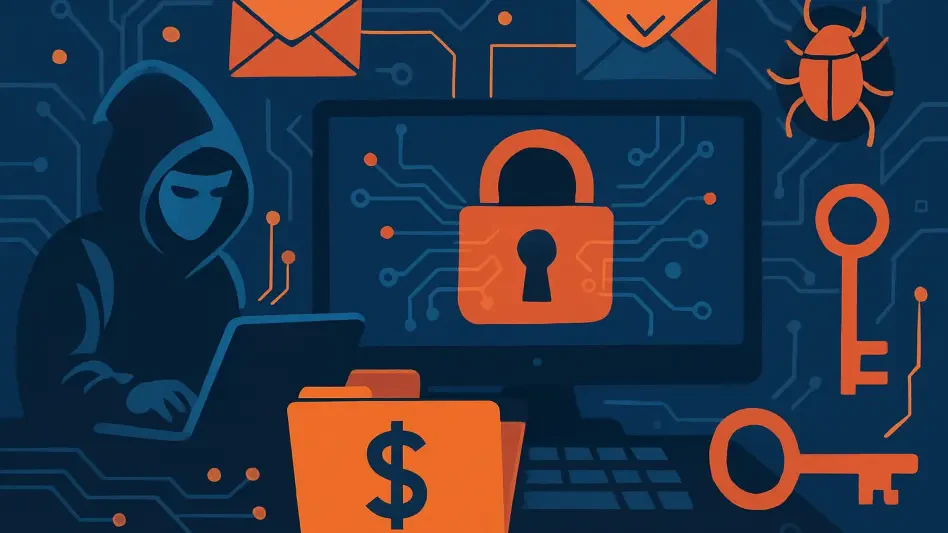In an era where digital security is paramount, a shocking case has emerged that challenges the very foundation of trust in the cybersecurity industry, shaking confidence in those tasked with protecting our digital world. Three U.S. professionals—Ryan Clifford Goldberg, Kevin Tyler Martin, and an unnamed co-conspirator—stand accused of orchestrating ransomware attacks using the notorious ALPHV/BlackCat strain. These individuals, entrusted with protecting organizations from cyber threats, allegedly exploited their expertise in incident response and ransomware negotiation to target vulnerable businesses. This betrayal raises profound concerns about who can be trusted to safeguard sensitive digital landscapes in an increasingly connected world.
The irony of cybersecurity experts turning to cybercrime underscores a critical ethical violation. With skills honed to defend against attacks, their alleged actions not only endangered the businesses they targeted but also cast a shadow over the integrity of their profession. This case prompts urgent questions about oversight mechanisms and accountability standards within the field. How can organizations ensure that those hired to protect them are not themselves a threat?
Background and Significance of the Investigation
The ALPHV/BlackCat ransomware group, which surfaced in late 2021, has gained infamy for targeting critical infrastructure, most notably in the 2023 Change Healthcare attack that compromised data of 190 million individuals and resulted in a $22 million ransom payment. This group’s sophisticated tactics have made it a persistent menace, disrupting essential services and exploiting systemic vulnerabilities. The current case involving cybersecurity insiders amplifies the gravity of such threats, revealing how intimate knowledge of defense strategies can be weaponized for malicious gain.
This investigation holds significant weight as it reflects a growing trend of insider threats within the cybersecurity realm. Professionals in roles meant to fortify digital defenses allegedly used their positions to perpetrate crimes, eroding trust in an industry that underpins modern society’s reliance on technology. The broader implications extend beyond individual companies to public confidence in digital systems, highlighting an urgent need for robust safeguards to prevent such breaches of duty.
The societal impact of this case cannot be overstated. As businesses and critical sectors like healthcare become more digitized, the potential for insider misuse of expertise poses a unique danger. This situation serves as a stark reminder that the cybersecurity field must evolve to address not only external threats but also internal risks that could undermine the safety of entire communities.
Details of the Alleged Crimes and Legal Proceedings
Nature of the Attacks
Between May 2023 and the present year, the accused trio allegedly targeted five U.S. businesses with ransomware attacks, leveraging the ALPHV/BlackCat strain to extort payments. The victims spanned diverse sectors, including a Florida medical company, a Maryland pharmaceutical company, a California doctor’s office, an engineering firm in California, and a drone manufacturer in Virginia. Their approach exploited vulnerabilities in these organizations, aiming to cripple operations and demand substantial ransoms.
A notable success for the group was the extortion of nearly $1.3 million from the Florida medical company in May 2023, a significant financial blow to the victim. However, their attempts on the other four targets over a six-month period in 2023 failed to yield additional payments, indicating varying degrees of resilience among the affected entities. These attacks highlight the calculated nature of the alleged crimes, focusing on sectors with high stakes and sensitive data.
The targeting of healthcare and engineering firms underscores the potential for widespread disruption, as these industries rely heavily on uninterrupted digital systems. The choice of victims suggests a deliberate strategy to maximize both financial gain and operational impact, painting a troubling picture of intent and sophistication behind the attacks.
Legal Actions and Charges
On October 2, 2023, federal prosecutors in the Southern District of Florida indicted Goldberg and Martin on multiple charges, including conspiracy to interfere with commerce by extortion, interference with commerce by extortion, and intentional damage to a protected computer. Each charge carries severe penalties, with the potential for up to 50 years in federal prison, reflecting the seriousness of the allegations against them.
Martin was arrested on October 14, 2023, and subsequently released on a $400,000 bond, entering a plea of not guilty. He faces strict conditions, including a prohibition from working in cybersecurity roles pending trial. Meanwhile, Goldberg, labeled a flight risk after travels to Europe and Mexico, was apprehended on September 22, 2023, in Mexico City, deported to the U.S., and remains in custody, awaiting further legal proceedings.
The legal actions underscore the government’s commitment to combating cybercrime, especially when perpetrated by those in trusted positions. The severity of the charges and the ongoing restrictions on the accused signal a broader effort to deter similar misconduct within the industry, setting a precedent for accountability in cases of insider threats.
Personal Motivations and Evidence
Behind the alleged crimes lie personal motivations that add a human dimension to the case. Goldberg reportedly confessed to FBI agents on June 17, 2023, admitting his involvement was driven by a desire to escape debt, earning a $200,000 share from the ransom extracted from the Florida medical company. This revelation points to financial distress as a key factor influencing his actions, contrasting sharply with his professional responsibilities.
Evidentiary support for the prosecution includes the seizure of Goldberg’s devices during his confession, providing critical digital footprints of the alleged activities. Such materials strengthen the case against him, offering tangible links to the ransomware operations. The combination of personal admissions and physical evidence presents a compelling foundation for the legal pursuit of justice.
The interplay of individual motives and professional betrayal raises complex questions about the psychological and economic pressures that might drive such behavior. While personal circumstances do not excuse criminal acts, they highlight the need for systemic support mechanisms to address underlying issues that could lead trusted professionals astray.
Industry Impact and Emerging Trends
Response from Employers
The employers of the accused, Sygnia and DigitalMint, reacted swiftly to the allegations, distancing themselves from the actions of their former staff. Sygnia terminated Goldberg upon learning of the charges, emphasizing a zero-tolerance stance on misconduct. DigitalMint clarified that Martin’s alleged activities occurred outside company systems, assuring stakeholders that no client data was compromised and noting that the involved individuals had not been with the company for over four months.
These responses reflect the reputational risks faced by organizations employing cybersecurity experts. Even with assurances of non-involvement, the incident casts doubt on internal vetting and monitoring processes. Companies in this sector must grapple with the challenge of ensuring their own defenses against the very insiders trained to protect them.
The difficulty of detecting such insider threats is a persistent concern for the industry. Organizations tasked with digital security must now reassess their protocols to prevent similar breaches of trust, balancing operational efficiency with rigorous oversight to safeguard both their clients and their own integrity.
Rising Insider Threats in Ransomware
Ransomware attacks, particularly those orchestrated by groups like ALPHV/BlackCat, have grown increasingly sophisticated, targeting critical sectors such as healthcare with devastating consequences. The involvement of insiders with deep knowledge of defense mechanisms amplifies the threat, as they can bypass security measures with alarming ease. This case exemplifies how expertise can be a double-edged sword in the fight against cybercrime.
The trend of insiders turning to criminal activities represents a unique challenge, as traditional defenses are often ill-equipped to counter threats from within. The ability of trusted professionals to exploit their access and skills for malicious purposes necessitates a rethinking of how cybersecurity roles are structured and monitored.
Healthcare and other essential industries remain prime targets for ransomware due to their reliance on uninterrupted systems and the high value of their data. This persistent focus by cybercriminals, combined with the potential for insider collusion, creates a volatile environment where the stakes for prevention and response are extraordinarily high.
Need for Reform in Cybersecurity
This case has sparked a consensus on the urgent need for reform within the cybersecurity field. Stricter regulations, enhanced monitoring systems, and comprehensive ethical training are seen as essential steps to prevent abuses of trust. The industry must prioritize mechanisms that deter misconduct while fostering a culture of accountability among professionals.
Beyond regulatory measures, there is a pressing need to strengthen internal safeguards within organizations. This includes regular audits, behavioral monitoring, and clear protocols for addressing potential conflicts of interest. Such reforms aim to protect businesses from internal threats while maintaining public confidence in digital security frameworks.
The broader implications of these reforms extend to rebuilding trust in a field critical to modern infrastructure. By addressing systemic vulnerabilities and emphasizing ethical responsibility, the industry can mitigate the risk of future insider threats, ensuring that cybersecurity remains a bastion of protection rather than a source of danger.
Reflection and Path Forward
Ethical and Professional Implications
Reflecting on this case reveals profound ethical and professional implications when cybersecurity experts allegedly engage in cybercrime. The personal motivations, such as financial distress, point to individual failures, while systemic gaps in oversight suggest broader industry shortcomings. This duality underscores the complexity of preventing such incidents in a field reliant on specialized expertise.
Balancing trust with accountability remains a significant challenge. Organizations must navigate the tension between empowering professionals with critical access and implementing checks to prevent misuse. This case highlights areas where industry practices, including vetting and support systems, could be strengthened to address both personal and structural risks.
The erosion of trust resulting from such actions affects not only the targeted businesses but also the perception of cybersecurity as a whole. Addressing these implications requires a multifaceted approach, combining policy changes with cultural shifts to reinforce the ethical foundation of the profession.
Future Directions for Prevention
Looking ahead, the cybersecurity industry must focus on developing robust vetting processes to identify potential risks before they manifest. Improved insider threat detection systems, leveraging advanced analytics and behavioral profiling, could provide early warnings of misconduct. These technological solutions should be paired with regular training to instill a strong sense of ethical responsibility.
Fostering a culture of transparency and accountability is equally critical. Encouraging open dialogue about ethical dilemmas and providing support for professionals facing personal challenges could mitigate factors that lead to criminal behavior. Industry-wide standards for ethical conduct might serve as a benchmark for maintaining integrity across organizations.
Unanswered questions remain about the effectiveness of legal deterrents in curbing insider cybercrime. Future efforts should explore how punitive measures, alongside preventive strategies, can create a comprehensive framework to protect against similar incidents, ensuring that the field evolves to meet emerging challenges.
Final Thoughts on Vigilance and Reform
The allegations against Ryan Clifford Goldberg, Kevin Tyler Martin, and their unnamed co-conspirator have marked a troubling chapter in the fight against cybercrime, as these cybersecurity professionals were accused of exploiting their expertise to orchestrate ransomware attacks with the ALPHV/BlackCat strain. Their successful extortion of $1.3 million from a Florida medical company, alongside failed attempts on other businesses, has exposed significant financial and ethical stakes. Legal proceedings, with severe charges and ongoing restrictions, have demonstrated the gravity of their alleged actions.
Moving forward, actionable steps must be prioritized to prevent the recurrence of such insider threats. Implementing advanced monitoring tools and mandatory ethical training programs can serve as critical deterrents, while fostering industry collaboration to share best practices could enhance collective defenses. Additionally, policymakers should consider legislation that mandates stricter accountability measures for cybersecurity roles, ensuring that trust is rebuilt through tangible reforms. This case has ultimately served as a catalyst for reevaluating how the industry safeguards its own, urging a proactive stance to protect digital landscapes from both external and internal dangers.








